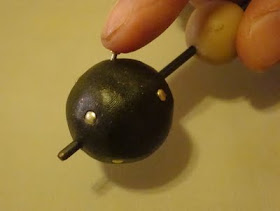Press conditioned polymer onto the mandrel until they are secured and not loose, then bake.
Apply liquid polymer clay in a thin layer.
Wrap bead with a layer of conditioned clay - this bead was wrapped twice.
Press out any air bubbles and smooth the surface carefully, too much force may loosen the bead.
Clip the nails with wire cutters or bolt cutters. I left about 3mm on the head.
Then push them into surface. This is a very satisfying step.
Then bake the finished bead....some of the nailheads got a little buried, but I don't mind.
Process: 1.Condition the polymer by kneading it until it is soft and warm. Don't skip this step, since it ensures completely mixed polymer which means stronger beads.
2.Decide how large you want your finished beads to be and roll out beads half that size. These will be the core beads that clay will be added to.
3. Push the clay beads onto the mandrel, compacting them to the metal so they adhere well.
4. Cure them in the oven at 275F for 15 minutes for every 1/4" thickness. Allow them to cool, or dunk them into cool water.
5. While the core beads are cooling, use wire cutters and trim the nails to about 1/8".
6. Apply a thin coat of liquid polymer to the cores (you can use a brush or your fingers), then roll out some conditioned clay and add a layer to the core bead, careful not to trap any air bubbles. This is best done by working from one end of the bead to the other, pushing out air as you press the clay onto the core.
7. Smooth the surface with your fingers, using the cuticle stick to get around the mandrel.
8. Press the trimmed nails into the clay and make a pattern or cover the surface. Smooth out any blemishes on the surface.
9. Cure the clay in the oven and while still warm, twist off the mandrel and cool. Tips: Rubbing alcohol works well to smooth uncured polymer clay. Twill works well to buff finished beads.







Looks great! How very useful! I hope everyone appreciates you carrying your polymer supplies all over hill and dale to do this... especially since the instructions can be found in your book.
ReplyDeleteI love these beads. So cool and I will give it a try. Thanks for posting this and I need to get your fabulous book!!
ReplyDeleteI love these beads, too! Great tutorial, and thanks.
ReplyDelete